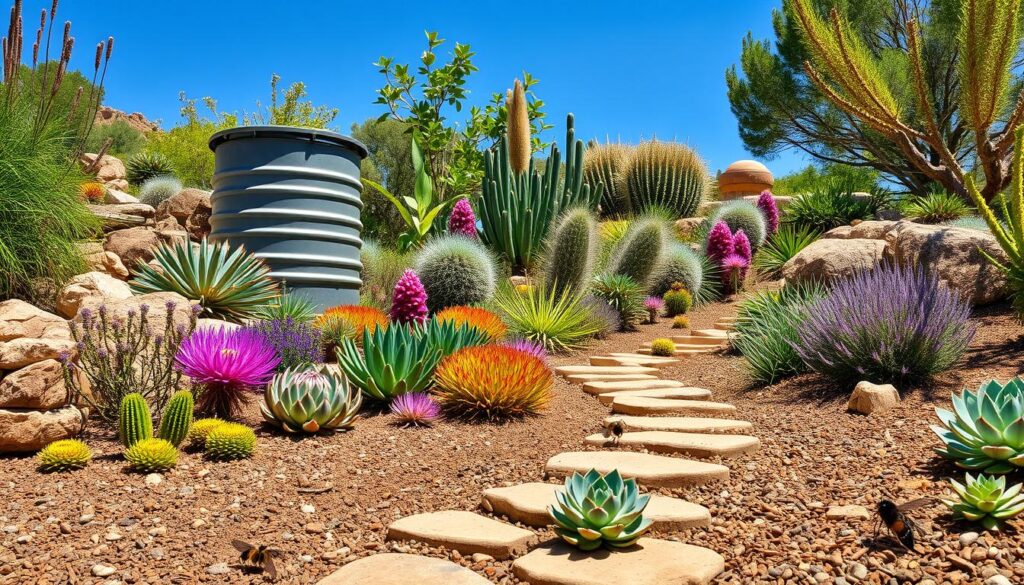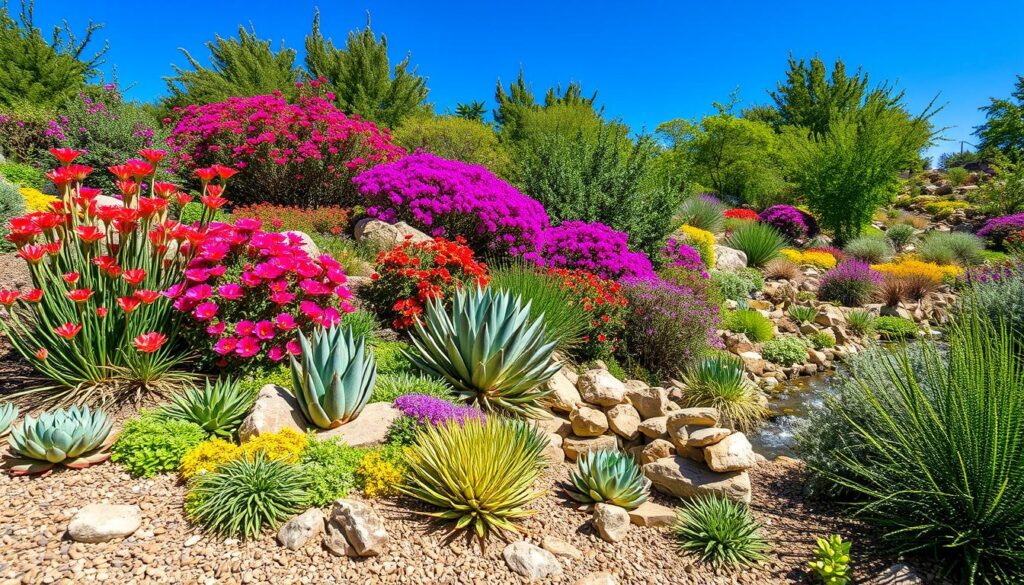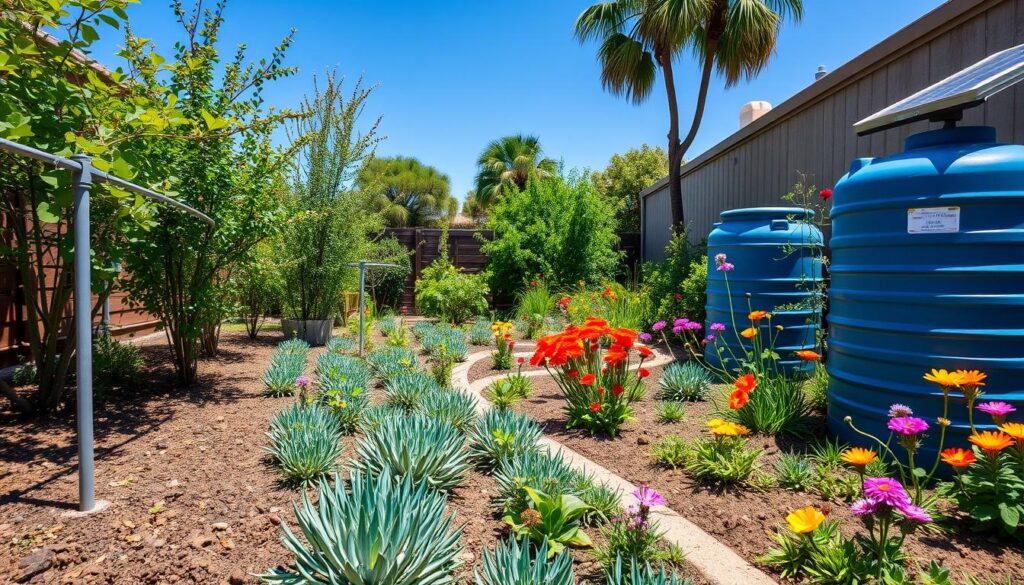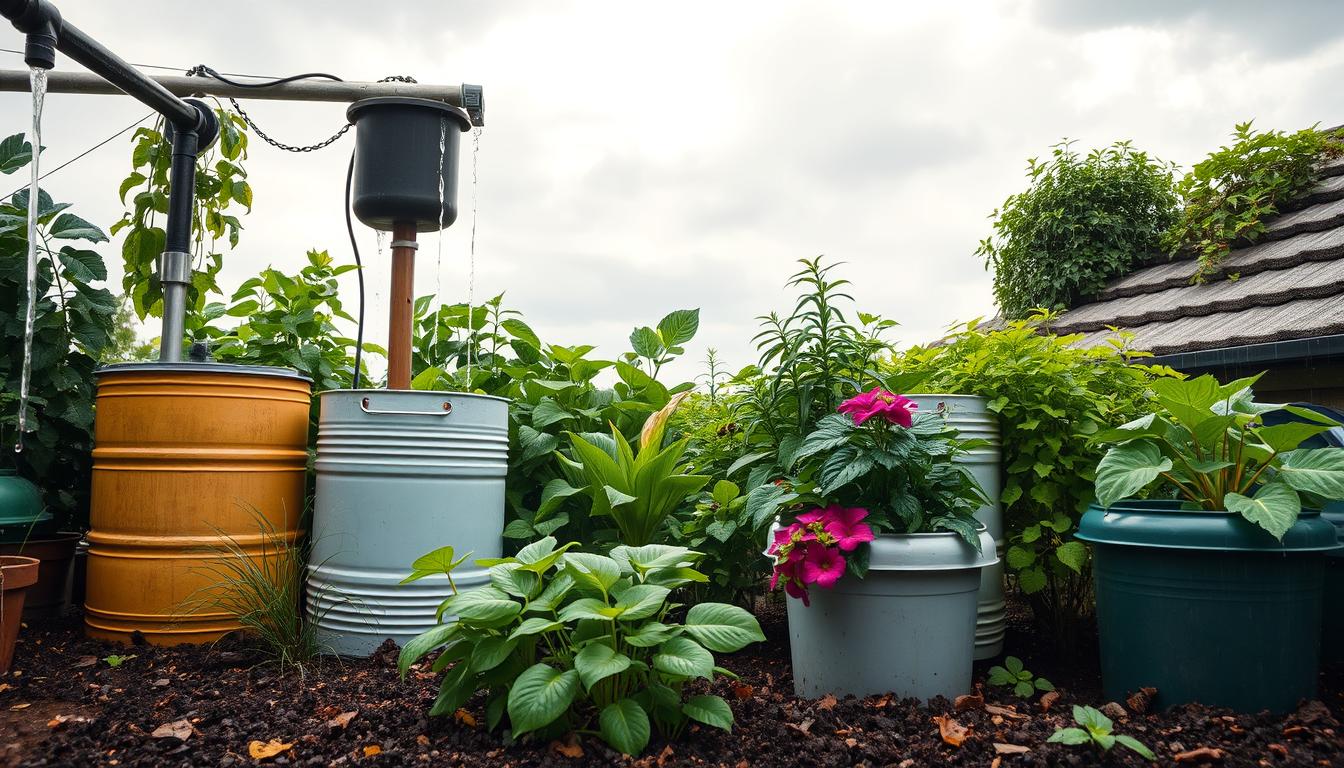Water scarcity is a big issue worldwide. In dry areas, gardening wisely is key. Many are now using plants that need less water and tips for green landscaping. These steps help save water and make gardens strong and beautiful.

Gardening sustainably is more than saving water. It’s about making outdoor spaces that are good for the planet. Using plants that don’t need much water and smart gardening can make a garden look great while being kind to the earth. With the right methods, anyone can have a garden that’s both beautiful and eco-friendly.
Introduction to Water-Wise Gardening
Water-wise gardening focuses on using water well. It helps save water, cuts down on costs, and makes gardens stronger. Whether you’re new to gardening or have been doing it for years, using water-wise methods can help the planet and your wallet.
Key Takeaways
- Water-wise gardening is essential for reducing water consumption in drought-prone areas
- Drought-resistant plants are a key part of sustainable landscaping
- Using sustainable gardening methods can save money and make gardens more durable
- Water conservation in gardening is vital for lessening environmental harm
- Adopting water-wise gardening practices can create a lovely and useful outdoor space while helping the environment
- Following sustainable landscaping tips can enhance a water-wise garden
Understanding Water-Wise Gardening Principles
Water-wise gardening saves water and cuts down on waste. It’s key in places where water is hard to find. It also lowers the harm traditional gardening does to the environment. By using eco-friendly methods, like xeriscaping and water-saving tips, gardens can be both lovely and green.
Key water-wise gardening ideas include picking plants that don’t need much water. Also, using smart irrigation and mulching to stop water from evaporating or running off. These steps help save water and lessen harm to the planet. Plus, using rainwater and gray water can cut down water use even more.
Water-wise gardening makes gardens that are good for the planet and save water. They also help local wildlife. Benefits include less water use, less stormwater runoff, and more wildlife. These gardens are also easy to care for.
Here are some tips for a water-wise garden:
- Choose plants that don’t need much water and use xeriscaping ideas.
- Use smart irrigation and water-saving tips.
- Mulch and compost to save water and reduce waste.
By following these tips and using eco-friendly gardening, you can make a beautiful, sustainable garden. This garden will save water and be kinder to the planet.
Assessing Your Garden’s Current Water Needs
To make your garden water-efficient, start by checking its current water needs. Look at your climate, soil type, and the plants you have. Eco-friendly landscaping can cut down on water use and protect the environment. Knowing your garden’s water needs helps you find ways to use less water.
Choosing plants that fit your local climate and soil is key to climate-resilient gardening. This reduces water waste and the need for extra watering. Also, using mulch and compost keeps the soil moist and stops water from evaporating. These steps help you create a water-saving, beautiful garden that also helps local wildlife.
- Monitoring rainfall and irrigation patterns
- Evaluating soil moisture levels
- Assessing plant water requirements
By following these tips and using water-efficient landscaping practices, you can make a stunning, eco-friendly garden. This garden will save water and help the environment.
| Factor | Description |
|---|---|
| Climate | Evaluate local rainfall and temperature patterns |
| Soil Type | Assess soil moisture levels and drainage |
| Plant Selection | Choose plants adapted to local climate and soil conditions |
Essential Elements of Drought-Resistant Landscaping
To make a drought-resistant landscape, you need to think about a few key things. Using drought-tolerant landscapinghelps cut down on water use. It keeps your garden looking great and healthy. Mulch and compost help keep the soil moist, so you don’t have to water as often.
Soil preparation is a big deal in drought-resistant landscaping. You should pick the right soil for your plants and add organic matter. This makes the soil better at holding water. Also, spacing plants right and zoning them helps save water and prevents plants from competing for it. These steps help make your garden more resilient to climate changes.
- Mulching to retain moisture and suppress weeds
- Using drought-tolerant plants that require minimal watering
- Implementing efficient irrigation systems that deliver water directly to the roots of plants
By using these eco-friendly garden practices, you can make a beautiful and sustainable outdoor space. Even in dry areas, your garden can flourish.
Selecting Drought-Tolerant Plants for Your Climate
Choosing the right plants is key for water-efficient gardening. Sustainable gardening in dry climates means picking plants wisely. Think about your local climate, soil, and moisture levels. Drought-tolerant plants help save water and grow well in dry areas.
Here are some tips for picking drought-tolerant plants:
- Research plants native to your region, as they are often more resistant to drought and require less water
- Look for plants with deep roots, which can tap into underground water sources
- Choose plants with small leaves or succulent leaves, which tend to lose less water through transpiration
For water conservation gardening, consider succulents, cacti, and plants like lavender and rosemary. These plants need less water. They make your garden beautiful and water-efficient.
Remember, water-efficient gardening is more than just plants. It’s also about soil, mulch, and how you water. Using these methods, you can have a garden that saves water and helps local wildlife.

The Water-Wise Garden: How to Garden Sustainably in Drought-Prone Areas
Creating a water-wise garden means using smart techniques to save water and cut down on waste. Xeriscaping is a top choice, using plants that need little water and efficient irrigation. This way, people can lessen their impact on the environment and make their gardens more eco-friendly.
To save water, you can use rainwater, recycle gray water, and choose plants that need less water. Here are some ways to do it:
- Install rain barrels to catch and store rainwater for watering plants.
- Use gray water recycling systems to reuse water from sinks, showers, and washing machines.
- Put in drip irrigation systems to water plants right at their roots.
By adding these ideas to your garden, you can make a lovely, green space. It will save water and need less fertilizers and pesticides.
Implementing Water-Efficient Irrigation Systems
Water-efficient irrigation systems are key in xeriscaping and saving water. They send water straight to the roots, cutting down on evaporation and runoff. This helps people use less water and make their gardens more eco-friendly.
Rainwater Harvesting Methods
Rainwater harvesting is a great way to save water in your garden. It lets you use rainwater instead of tap water, making your garden more sustainable. You can use rain barrels, cisterns, or other systems to store rainwater.
Smart Technology for Water Conservation
Exploring water-saving garden ideas leads us to smart technology’s role in water use. Environmental landscaping gets a boost from automated systems. These systems help save water in gardens. By using drought-tolerant plants and smart tech, gardens can be both sustainable and lush.
Some key technologies to consider include:
- Automated irrigation controllers, which adjust watering based on weather and soil moisture
- Soil moisture sensors, giving real-time data on soil health to avoid overwatering
- Weather-based watering systems, using forecasts to set the best irrigation times
These technologies help gardeners cut down on water waste. For instance, a study by the Environmental Protection Agency shows smart irrigation can save up to 30% of water. By mixing these techs with water-saving ideas and green landscaping, gardens become both beautiful and water-efficient.

| Technology | Benefits |
|---|---|
| Automated irrigation controllers | Adjusts watering schedules based on weather conditions and soil moisture levels |
| Soil moisture sensors | Provides real-time data on soil conditions and helps prevent overwatering |
| Weather-based watering systems | Optimizes irrigation schedules based on weather forecasts |
Maintaining Your Water-Wise Garden Through Seasons
To keep your garden thriving, adapt your maintenance to the seasons. Sustainable gardening in dry regions needs careful planning. By using eco-friendly garden design, you can save water and have a beautiful garden.
Xeriscaping for water efficiency is a great way to save water. It uses drought-tolerant plants and efficient irrigation. Also, using rain barrels and gray water systems can cut your water bill and help the environment.
Here are some tips for maintaining your water-wise garden all year:
- Monitor soil moisture levels to avoid overwatering
- Adjust your irrigation schedule according to seasonal weather patterns
- Use organic mulch to retain moisture and suppress weeds
- Prune plants regularly to promote healthy growth and reduce water consumption
Follow these tips and use sustainable gardening in dry regions principles. You’ll have a stunning and eco-friendly garden that thrives all year. Always be mindful of your water use and adjust as needed for your garden’s health and beauty.
Conclusion: Creating a Sustainable Garden Legacy
Creating a water-wise garden is more than saving water. It’s about leaving a lasting legacy for future generations. By using water-efficient gardening, you can make beautiful, drought-tolerant landscapes. These landscapes not only enhance your home but also help the environment.
As you work towards a water-saving garden, remember every small step counts. Use drought-tolerant plants and smart irrigation systems. This way, you save water and encourage others to garden sustainably.
Your water-wise garden shows your dedication to the environment and a greener future. It’s a chance to lead by example and help others become more water-conscious. Together, we can create an eco-friendly garden that benefits our homes and the planet.
FAQ
What is water-wise gardening?
Water-wise gardening is about saving water and being kind to the environment. It means choosing plants that don’t need much water and using smart irrigation systems. It also means using eco-friendly gardening methods.
What are the benefits of a water-wise garden?
A water-wise garden uses less water and needs less care. It also makes your garden more eco-friendly. By gardening wisely, you help save water and make your garden strong even in dry times.
How do I assess my garden’s current water needs?
First, think about your local weather, soil, and plants. Look at how you water now and find ways to use less water. You can also try new, water-saving gardening ideas.
What are some essential elements of drought-resistant landscaping?
Key parts of drought-resistant landscaping are good soil and using mulch. Also, space plants wisely and zone them correctly. These steps help your garden survive with little water.
How do I select drought-tolerant plants for my climate?
Choose plants that fit your local weather and soil. Pick native or adapted plants that need less water. Look for plants with deep roots or waxy leaves to help them survive dry spells.
What water-efficient irrigation systems can I use in a water-wise garden?
Use drip irrigation, soaker hoses, and smart controllers for your garden. These systems save water and make sure plants get the right amount of moisture.
How can I incorporate rainwater harvesting and gray water recycling in my water-wise garden?
Collect and store rainwater for your garden, and reuse household water for irrigation. These methods cut down on your need for city water and give your plants a sustainable water source.
What smart technologies can I use to enhance water conservation in my garden?
Try automated irrigation controllers, soil moisture sensors, and weather-based watering systems. These smart tools help save water, reduce waste, and keep your plants healthy.
How do I maintain a water-wise garden through the seasons?
Adjust your gardening to fit the changing weather and plant needs. Change your watering schedule, use mulch, and pick plants that do well in your area’s seasons.




